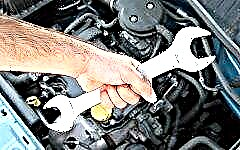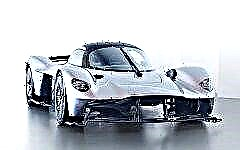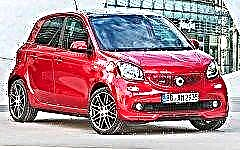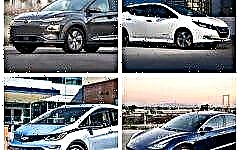
Since the dawn of civilization and the invention of the wheel, mankind has discovered the need to create new ways and improve means of transportation, making the movement of people and goods easier and faster. Carts have turned into cars. Today we look not only at their appearance and performance, but also at their convenience, efficiency, and environmental friendliness.
In an effort to meet our needs, automakers have started to actively electrify their products. The suggestions are dazzling, but we will select the best in the most important classes.
Electric motors for power and economy

Once hybrid cars were considered a utopia, today there is a huge selection of different brands, modifications and trim levels on the market. Let's take a closer look at them.
The term "hybrid" refers to a car that has at least two energy sources - a traditional one that uses gasoline or diesel fuel and an electric one. Thanks to cooperation, fuel consumption is significantly reduced, as well as environmental damage.
Among the most economical and environmentally friendly cars, electric ones are still in the lead, but they are not bought as readily as hybrid ones. The latter are powered by both conventional fuel and electricity, without polluting the environment with destructive emissions and without creating additional noise. But hybrids are different. Let's consider the most common categories:
- Full hybrid vehicles: A regular gasoline (or diesel) internal combustion engine is used only to recharge the energy battery. They are practically electric cars, and at the moment they are the most economical;
- Parallel: the car is driven simultaneously by an electric unit and a conventional one;
- Sequential: capable of running on electricity only (within the city) or only on fuel (on highways);
- "Soft": the electric motor is only activated in difficult situations when additional power is needed - during hard acceleration, for example, or when going uphill. The internal combustion engine is turned off when coasting, braking and idling when idling. When sharp acceleration is required, both units come into play: the electric helps the gasoline one, as a result, good dynamics and economy are maintained. The powerful starter allows you to start instantly, and the fuel economy reaches up to 30% against the background of conventional non-hybrid cars.
- Plug-in hybrids: These machines are capable of being charged from the mains. When it is possible to systematically feed the battery from external sources (charging stations or devices), you can ride on electricity alone. If not, when the energy supply is depleted, the internal combustion engine will turn on. This is their advantage over electric vehicles - they will not be able to move when the energy storage is empty.
7 great options for the conscious buyer
For the summer of 2020, global oil and oil prices remain at multi-year lows, prompting many drivers to ignore economy when choosing their next car. But the cost of gasoline and diesel fuel is still not going to zero, and reasonable people are trying to save money by choosing the car with the most efficient use of fuel. It is also a defense against prices that might spike in the future.
The most frugal can choose a used car instead of a new one. We are not talking about ancient pieces of iron that barely hold up - rather, about recently produced, little exploited, in excellent condition and with all the technological improvements. But it is better to buy a new car that will give you a greater margin of operating time and, if you are restrained with the level of equipment and options, will not cost much more.
Next is the top list of hybrid vehicles with good fuel economy, from humble subcompacts to luxury SUVs. But first, what's the difference between fully hybrid and plug-in hybrid models?
In short, both drives can propel the vehicle exclusively electrically. But if in the first case, only a small battery is installed that can be charged by restoring braking energy, then plug-in hybrids contain a battery with a larger capacity, which can be charged using a plug-in connector. This allows them to travel long distances on clean electricity. True, they are more expensive.
So, here are the best hybrid cars of 2020:
- small car: Toyota Yaris;
- compact class: Volkswagen Golf GTE;
- middle level: Mercedes C 300 de;
- mini crossover: Hyundai Kona Hybrid;
- compact SUV: Ford Kuga;
- mid-size SUV Audi Q5 TFSI e;
- upper class of mid-size SUVs: the BMW X5.
Toyota Yaris 2020

The car is economical and extremely comfortable, especially in the city. Toyota's hybrid engine is considered "mature" and not very error prone. The Yaris is at the top for many reasons, including ease of handling and compact size, but most importantly, good economy and breakdown statistics.
In the summer of 2020, dealers will have a new edition of the small hybrid car with a prettier body and the latest generation of improved drivetrains. Toyota has been a pioneer when it comes to production hybrids. It is all the more surprising that the Japanese made this subcompact eight years single-handedly to fight with competitors.
VW Golf GTE

In the compact class, the VW Golf has become a role model and has spawned a mass of followers. This year, Wolfsburg's bestseller launches in its eighth generation. Again, the plug-in hybrid Golf will be reborn. It's going to be fun: the 2020 Golf 8 GTE will be as strong as the GTI. The 1.4-liter petrol engine (150 hp) and the electric motor (85 kW) jointly mobilize the system with 245 hp, while the lithium-ion battery stores energy for 60 km of pure electric range.
In EV mode, the GTE will be able to reach a top speed of 130 km / h, but when both engines work together, the car runs much faster - the top speed exceeds 200 km / h.
The sports-hybrid GTE will be priced slightly higher than the similarly strong GTI. The principle of hybrid technology also extends to other, more utilitarian versions of the Golf. All four-cylinder petrol engines with dual-clutch transmission receive at least mild hybrid support via a belt-driven starter generator. However, only the Golf GTE becomes a "real" hybrid.
Mercedes-Benz C300 de

There are not many manufacturers that combine plug-in hybrid technology with a powerful diesel drive. Both technologies are complex and expensive in and of themselves, especially their combination. But Mercedes is following the wishes of the customers: a 2.0-liter four-cylinder diesel unit with 194 hp works together in the C300de. and a 122-horsepower electric motor. Diesel of the OM 654 series is extremely clean in all dimensions. The C-Class Hybrid mobilizes a total of 306 hp, accelerating from 0 to 100 km / h in 5.6 seconds.
However, performance is of secondary importance here. Despite the additional weight (about 300 kg), the C300 de consumes noticeably less fuel than the equally powerful "clean diesel" and can drive in the city with absolutely no emissions.
The Mercedes product is good for everyone, except for the price - a hybrid diesel plug-in from a prestigious German manufacturer starts at 49,105 euros excluding government subsidies. The base price for the C-Class Estate is € 50,771.
Hyundai kona

Don't be afraid of tall curbs - the popular mini SUV with its compact size and trendy shape is ideal for urban parking maneuvers. The nimble all-wheel drive hybrid crossover has a length of 4.16 meters. It is powered by a 1.6-liter petrol engine and a 44-horsepower electric motor, which together develop 141 hp. It is a great addition to Hyundai's petrol, diesel and electric mini-SUVs.
The small car adopts the hybrid system from its sister models Hyundai Ioniq and Kia Niro. The Koreans adhere strictly to their strategy of progressive electrification, whose main principle is to gradually introduce electrified versions into existing production line-ups.
Following this plan, the Kona is offered in a variety of guises, from conventional fuel to all-electric. In the hybrid variation, the 1.6-liter petrol four-cylinder runs on the efficient Atkinson cycle, complemented by an electric motor and six-speed dual-clutch transmission. At a base price of around € 27,000, the Kona Hybrid costs around € 3,000 more than its comparable gasoline counterpart.
Ford Kuga

Kuga appeared not so long ago and immediately became a bestseller among compact SUVs. This is a true all-rounder - roomy, comfortable and reliable: 4.61 meters long, 1.88 wide and 1.67 high. The third generation will be launched in 2020. If earlier Ford did not attract attention with a wide range of alternative versions, now the situation is changing. The Kuga is available in three hybrid versions: a mild hybrid, full and plug-in with a larger traction battery.
In the first case, a 48-volt electrical system supports a two-liter 150-horsepower diesel engine. In tests, this version of the Kuga demonstrates good cross-country ability and amazing economy for an off-road crossover.
At its launch in spring 2020, Ford unveiled the plug-in hybrid model starting at € 39,550. Here, Ford electrifies the 2.5-liter four-cylinder petrol engine and brings power to 225 hp. At the end of the year, the Ford Kuga should also be available from dealerships as a full hybrid without a 14.4 kWh traction battery. Many options, reasonable prices, typical maneuverability and driving characteristics are the main advantages of the Ford Kuga Hybrid.
Audi Q5 TFSI-e

Plug-in-Hybrid is increasingly becoming the “new norm” for large crossover makers. This applies more to premium car manufacturers such as Audi.
The Ingolstadt company has been offering the e-variants TFSI 50 and 55 since 2019 as part of the mid-size Q5 series. Here, Audi combines a 2.0-liter 4-cylinder petrol unit with an electric motor (143 hp) housed in a seven-speed robotic box unit.
Depending on the version, the crossovers generate 299bhp. or 367 hp The battery (14.1 kWh) provides more than 40 kilometers of electric travel - one of the prerequisites for government funding and increasing consumer interest.
Fuel consumption with mixed food is scanty - 2.7 l / 100 km. However, as with every PHEV, the following rule applies - if you often accelerate and choose the wrong profile (driving mode), do not expect much savings. The price list starts at about 54,000 euros.
Bmw x5

The larger and heavier the cars, the more likely manufacturers will adopt electrification. On the one hand, the fuel economy effect is beneficial for bulky SUVs like the X5. On the other hand, it provides room for additional technologies.
And one more plus - customers in these car classes are not particularly price sensitive. It is therefore not surprising that the current BMW is giving the second generation X5 xDrive45e an alternative drive.
The current model is based on a 3-liter inline-six. The electric motor (112 hp) supports a 286-horsepower turbocharged petrol unit. A powerful system of 394 hp. enough for a luxury SUV 4.92 meters long, providing excellent driving performance. It accelerates from 0 to 100 km / h in 5.6 seconds. A charge storage capacity of 24 kWh is also enough to guarantee a minimum of 87 kilometers of electrical range.
The BMW X5 has never been cheap and this interpretation costs 77,300 euros. Standard equipment includes air suspension with electronically controlled shock absorbers and four-wheel drive. The electrified X5 is available from the end of 2019.
Conclusion
These are just a few of the range of hybrid vehicles on the market today. Fuel-efficient hybrid vehicles are becoming more and more popular - this can be seen in the huge number of new proposals over the past few years. Even manufacturers of expensive, luxury and sports cars have come into play. Explore and compare different hybrid vehicles. In the market, the main thing is the choice, and the decision, as always, is yours.

|| list |
- Electric motors for power and economy
- 7 great options for the conscious buyer
- Toyota Yaris 2020
- VW Golf GTE
- Mercedes-Benz C300 de
- Hyundai kona
- Ford Kuga
- Audi Q5 TFSI-e
- Bmw x5











